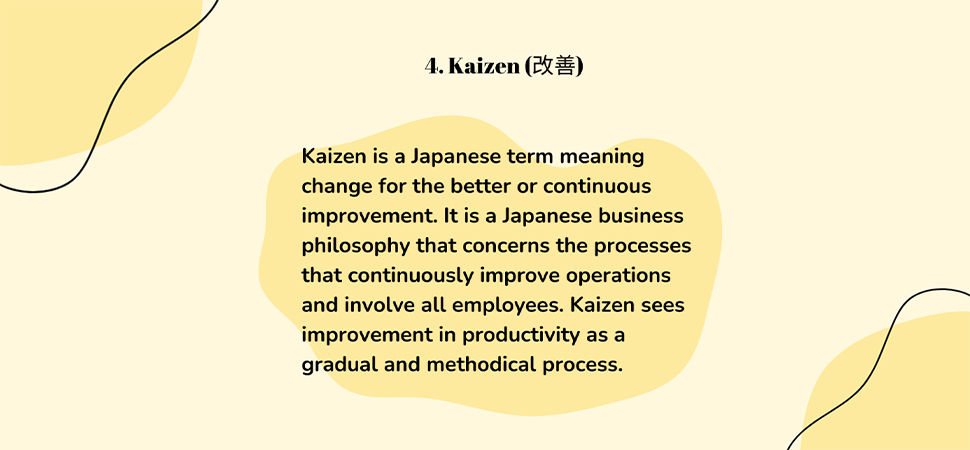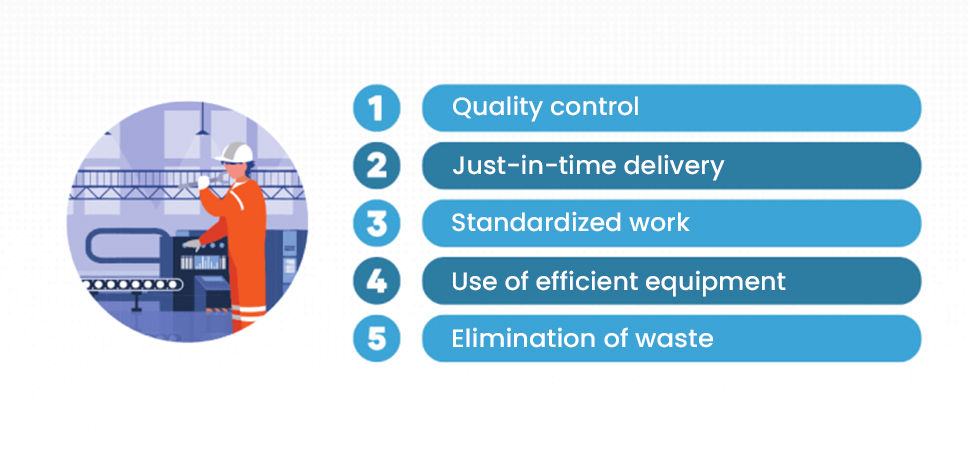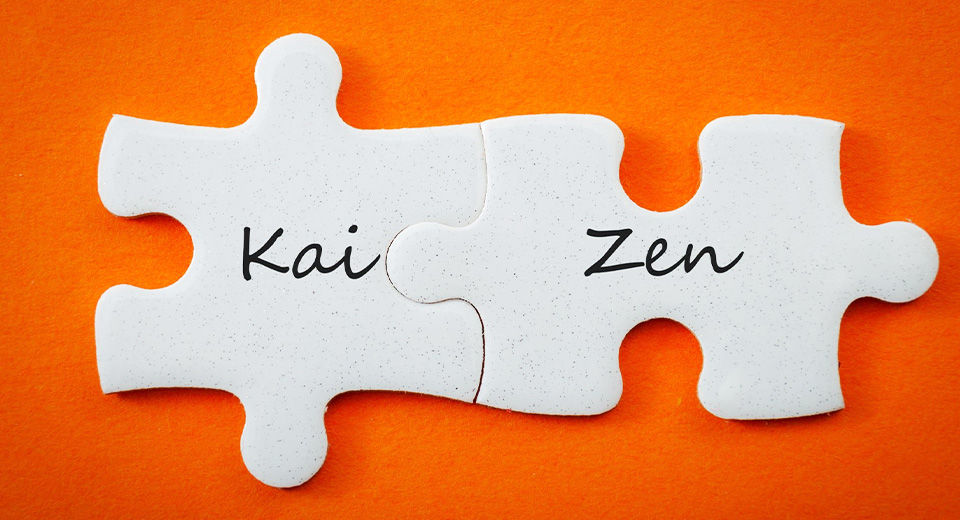Kaizen Meaning

As mentioned earlier, Kaizen is a philosophy of continuous improvement. It focuses on making small, incremental changes that lead to significant improvements over time. This approach encourages all employees, from the top management to the front-line workers, to consistently look for and implement ways to improve processes and systems.
10 Guiding Principles: Empowering Continuous Improvement

Kaizen is guided by 10 principles that serve as a foundation for its implementation. These principles include:
-
Assumptions are easy to make, but they don’t align with its principles.
-
Make the “improvement” term a habit.
-
Gather information from various individuals.
-
First, identify mistakes, then shift the focus to solutions.
-
Create an environment that fosters the achievement of organizational objectives with utmost efficiency and effectiveness.
-
Take a proactive approach to problem-solving.
-
Rather than striving for perfection, it is more beneficial to embrace adaptive change.
-
To uncover the underlying cause, delve deeper by repeatedly questioning "why" five times rather than settling for surface-level explanations.
-
Discover cost-effective minor enhancements through the power of creativity.
-
Pursue excellence relentlessly and refuse to accept mediocrity as the norm.
Understanding the Working of Kaizen with 5 Major Objectives

Kaizen has five major objectives that guide its implementation. These include:
-
Quality control
-
Just-in-time delivery
-
Standardized work
-
Use of efficient equipment
-
Elimination of waste
Various Steps in Kaizen to be Followed

Kaizen is an ongoing process that requires consistent effort and dedication. The steps involved in practicing Kaizen include:
-
Gather employee feedback to identify problems, creating a comprehensive list if necessary.
-
Motivate employees to generate solutions and select the best from the options presented.
-
Implement the chosen solution with full participation from everyone involved.
-
Analyze the results periodically to track progress and evaluate the effectiveness of the implemented solution.
-
If the results are satisfactory, implement the solution across the entire organization. Encourage employee involvement by delegating responsibilities to identify issues and gather information.
-
Keep on performing the steps mentioned above on a repeat basis. Keep on identifying newer problems and testing more unique solutions.
The 5S Framework

The 5S framework involves organizing and maintaining a clean workplace to improve efficiency, safety, and quality. The five S's stand for:
-
Shitsuke/Sustain: This entails practicing discipline and exerting persistent effort.
-
Seiso/Shine (cleanliness): This involves guaranteeing the cleanliness and tidiness of the workspace, ensuring a hygienic and organized environment.
-
Seiri/Sort: This entails distinguishing between essential and nonessential items, ensuring a clear distinction between what is necessary and what is not.
-
Seiton/Set in order: This entails organizing items to promote effortless and swift accessibility.
-
Seiketsu/Standardize: This entails implementing standardized cleanup procedures by adopting the most efficient practices.
Major Benefits of Kaizen

Kaizen offers numerous benefits to organizations, including:
-
Increased efficiency and productivity: Continuously improving processes increase efficiency and productivity.
-
Enhanced quality: Focusing on quality leads to better products and services.
-
Reduced waste and costs: Eliminating waste results in cost savings for the organization.
-
Improved employee morale: Involving employees in improvement leads to better morale and engagement.
-
Better customer satisfaction: By delivering high-quality products and services efficiently, customer satisfaction is greatly improved.
What Role Does Management Play in a Kaizen System?
Management plays a crucial role in implementing Kaizen within an organization. They are responsible for setting goals, providing resources, and creating a culture of continuous improvement. Also, management must actively participate in the improvement process and lead by example.
Just-in-Time (JIT) Inventory Strategy
%20Inventory%20Strategy.jpg?updatedAt=1704440481933)
The Just-In-Time (JIT) Inventory Strategy is a key component of the Kaizen concept, which focuses on continuous improvement and efficiency in business operations. JIT inventory involves keeping only the necessary amount of inventory on hand at any given time, minimizing waste and excess inventory costs. This strategy allows businesses to respond quickly to changes in demand and production needs, reducing lead times and increasing overall efficiency. In the Kaizen philosophy, JIT inventory is seen as a way to eliminate waste and improve processes through constant evaluation and improvement.
By implementing this strategy, businesses can save costs and create a more streamlined and effective operation. "Kaizen" means "change for the better," reflecting the focus on continual improvement in all business operations. By adopting JIT inventory as part of the Kaizen approach, businesses can stay ahead of the game and continuously improve their processes for better overall results. So, it's clear that JIT inventory plays a crucial role in the Kaizen philosophy and is an essential strategy for any business looking to optimize its operations and improve efficiency.
Explaining the Continuous Improvement Mindset in Kaizen

Kaizen is centered on the mindset of continuous improvement, constantly exploring ways to enhance processes, products, and services. It embodies the pursuit of perfection through refinement and innovation. This mindset empowers employees to take proactive ownership of their work and consistently identify areas for incremental enhancements. By embracing Kaizen as an ongoing process, organizations can achieve enduring success and maintain a competitive edge. The key takeaway is that Kaizen isn't a one-time event but a commitment to unwavering dedication and a relentless pursuit of constant improvement.
With its guiding principles and objectives, Kaizen offers a pragmatic and effective approach to fostering ongoing improvement across all facets of an organization. If you aspire to drive positive change and thrive in your business endeavors, consider embracing Kaizen principles and cultivating a continuous improvement mindset. So, let's delve into the concept of Kaizen and commit wholeheartedly to constantly enhancing ourselves and our organizations. As the adage goes, even small strides can pave the way for monumental transformations! Keep persevering in your pursuit of progress, one step at a time.
Kaizen, a Japanese term, is often misinterpreted as a slow process. Ignoring its significance in the long run and ignoring its effectiveness for a better future. It is, moreover, like a routine that requires small steps consistently. Finally, Kaizen has proved to be a great solution for those who want to grow in the long run and prefer quality over quantity.










